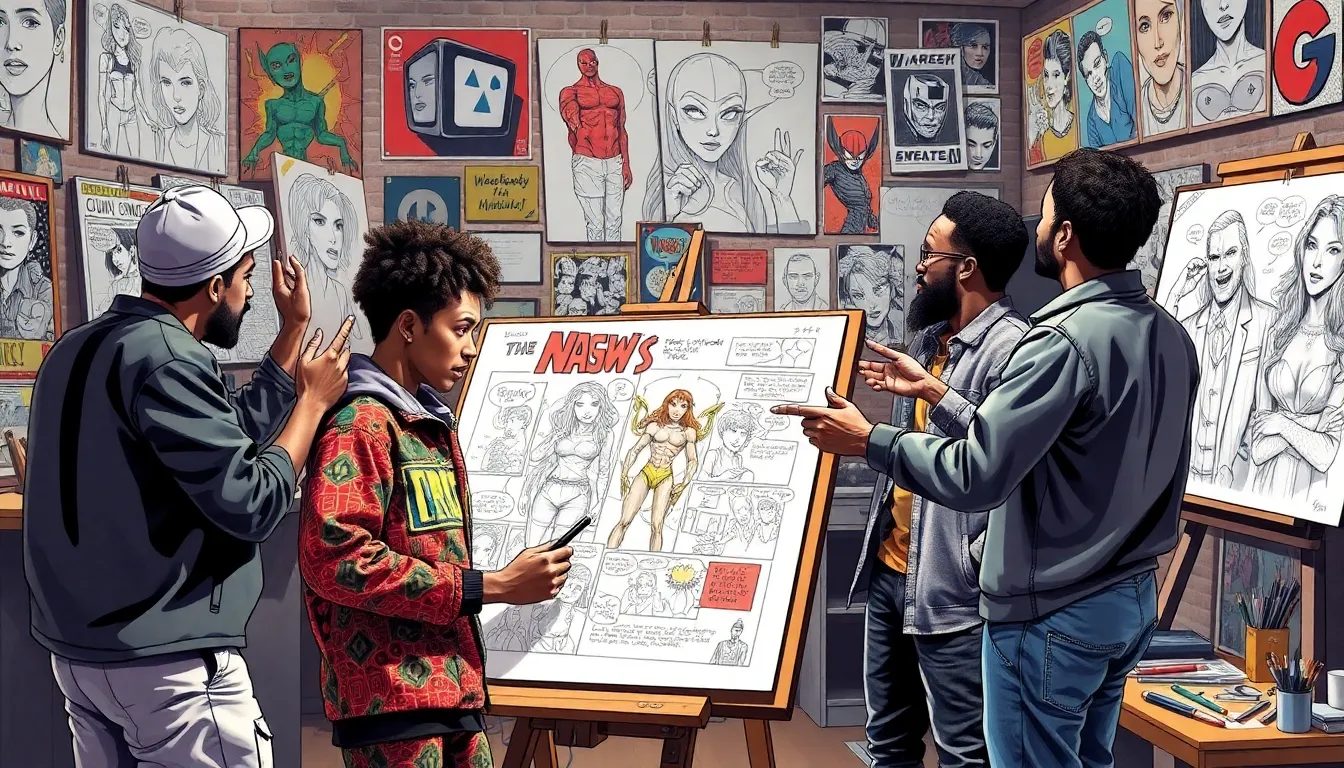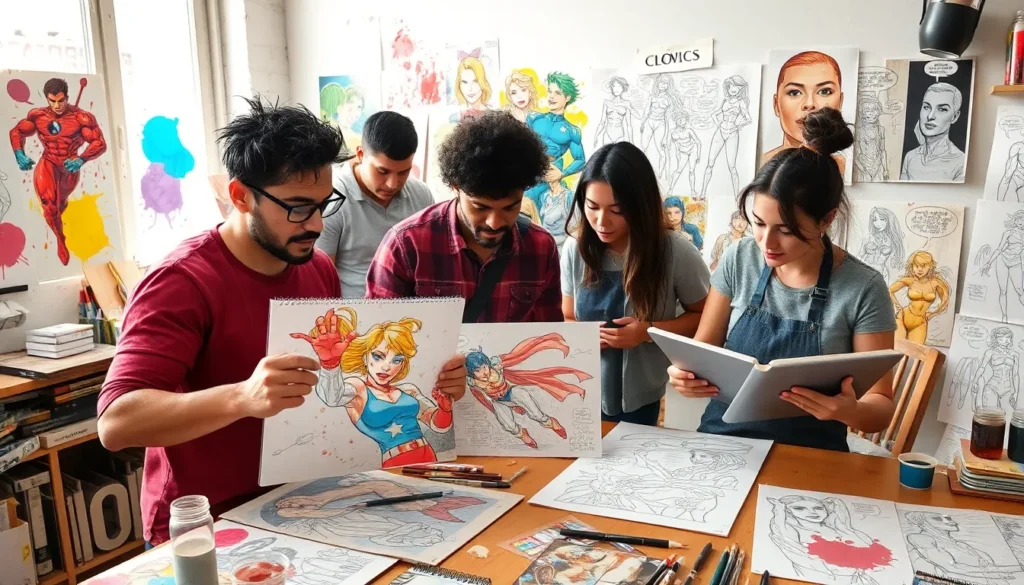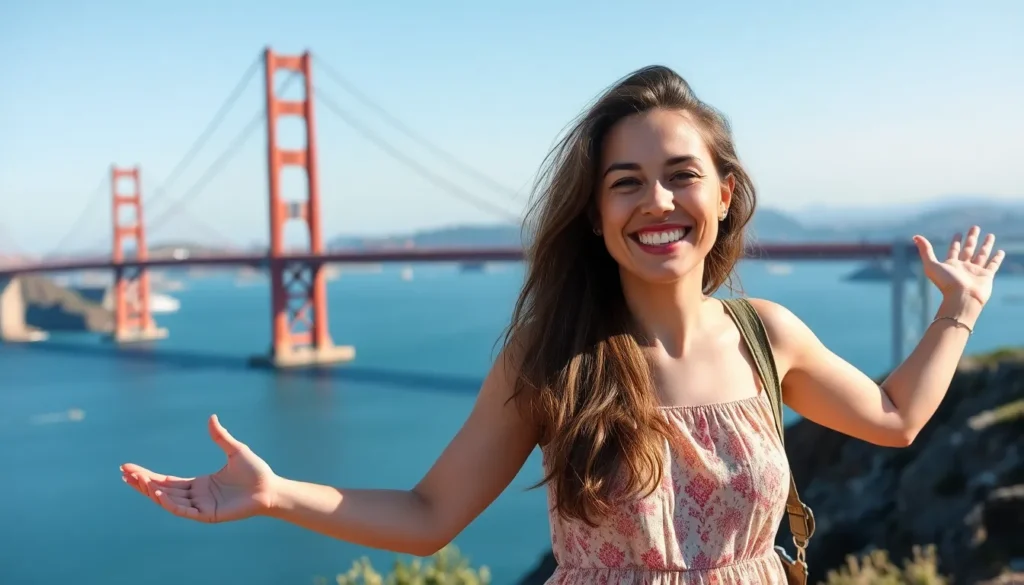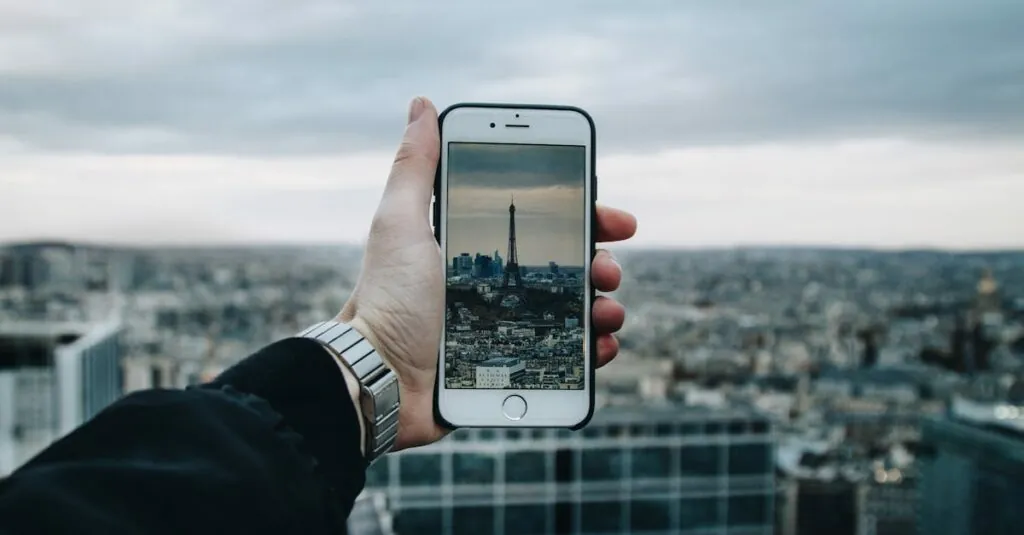Table of Contents
ToggleComic book art isn’t just about capes and spandex; it’s a vibrant universe bursting with creativity and inspiration. From the bold colors that leap off the page to the dynamic characters that seem ready to jump into action, the art form captivates audiences of all ages. Whether it’s the classic works of legends or the fresh styles of emerging artists, comic book art has a unique way of sparking imagination.
But what fuels this artistic fire? It’s a delightful mix of culture, history, and a dash of whimsy. Every panel tells a story, and behind each stroke lies a treasure trove of inspiration waiting to be uncovered. So grab your sketchbook and let’s dive into the colorful world of comic book art, where creativity knows no bounds and every artist can find their muse.
Understanding Comic Book Art Inspiration
Comic book art thrives on a unique blend of influences, drawing from various sources that inspire creativity. Many artists often look to popular cultures, such as movies, music, and literature. These sources inject life into characters and narratives, creating relatable and engaging stories.
Art history also plays a crucial role in shaping comic book visuals. Renowned styles, such as Pop Art and Surrealism, contribute vibrancy and flair to modern comics. Influences from celebrated artists often inspire graphic novelists to explore new techniques and aesthetics.
Cultural heritage shapes themes and character designs, tapping into folklore, mythology, and societal norms. Artists frequently weave these elements into their work, enriching the storytelling experience with familiar motifs. Diverse backgrounds create an array of artistic expressions, ensuring comic books resonate with a broader audience.
Collaboration remains essential in the comic book industry. Writers, illustrators, and colorists work cohesively to craft visually stimulating narratives. Such teamwork ensures a harmonious blend of text and imagery, enhancing the overall impact of comic book stories.
Engaging with art forms outside of comics also stimulates inspiration. Many artists find joy in studying paintings, sculptures, and photography, allowing cross-disciplinary influences to inform their work. This practice encourages exploration and innovation, leading to fresh perspectives within comic art.
Ultimately, comic book art emerges from a dynamic interplay of influences, experiences, and collaborations. Readers are invited to engage with this rich tapestry, sparking their own creativity as they explore the vibrant world of comic book art.
Influential Artists and Their Styles

Comic book art showcases diverse influences, with various artists leaving a distinct mark on the medium. Understanding their work provides insight into the evolution of comic art.
Classic Comic Heroes
Comic book art often draws inspiration from iconic figures. Artists like Jack Kirby defined the superhero genre with explosive action and dynamic poses. Their bold linework and vibrant colors captured the essence of heroism. Meanwhile, artists such as Will Eisner elevated storytelling through innovative panel designs. They blended text and image seamlessly, creating immersive narratives that captivated readers. Such contributions established the visual language of comics, celebrating the heroic adventures that remain popular today.
Modern Influencers
Contemporary artists continue to push boundaries within comic book art. Creators like Scott Snyder and Greg Capullo redefine character development and storytelling techniques. Their collaborations introduce darker themes and complex narratives, appealing to modern audiences. Another notable figure, Fiona Staples, merges traditional comic styles with digital techniques, enhancing visual depth and character emotion. The unique blend of influences shapes contemporary comic art, reflecting societal shifts and personal experiences. Each artist contributes to this rich tapestry, inspiring a new generation of creators and readers alike.
Sources of Inspiration in Comic Book Art
Comic book art draws from various rich sources of inspiration. These influences shape storytelling and character development, enriching the artwork’s depth.
Literature and Mythology
Literature serves as a significant foundation for comic book narratives. Famous works, such as Shakespeare and Greek tragedies, inspire character arcs and conflicts. Mythology often provides archetypal heroes and villains, allowing artists to explore universal themes. Characters like Thor and Wonder Woman stem from mythological traditions, demonstrating the lasting impact of these stories. Adaptations of classic tales into comic formats further illustrate how literary sources can enhance visual storytelling.
Film and Television
Film and television significantly influence comic book art. Cinematic techniques, such as dynamic framing and pacing, translate well into panel design, creating visually striking pages. Iconic films often inspire original characters and storylines, as seen with superhero franchises. Additionally, television series allow for episodic storytelling, encouraging comic artists to experiment with character development across issues. This cross-pollination of media fosters creativity and keeps comics aligned with contemporary culture.
Everyday Life
Everyday life provides a wellspring of inspiration for comic book artists. Observations of human behavior, social interactions, and urban environments shape relatable characters and scenarios. Artists frequently incorporate real-world experiences to make narratives resonate with audiences. Cultural events and societal issues also influence themes, reflecting current events and fostering discussion. The connection between everyday life and comic art ensures that stories remain relevant and engaging for readers of all backgrounds.
Techniques for Creating Comic Book Art
Comic book art employs various techniques that enhance storytelling and engage audiences. Artists harness their skills to bring characters and narratives to life through detailed illustrations and thoughtful color application.
Drawing and Illustration
Illustration serves as the foundation of comic book art. Artists begin with sketches that capture movement, emotion, and personality. Building upon rough drafts, they refine lines and add details that breathe life into characters. Dynamic perspectives and varying panel layouts keep readers engaged. Tools like pencils, inks, and digital software help artists create unique styles. Classic techniques coexist with modern digital methods, allowing for experimentation. Collaborating frequently, illustrators and writers ensure that visual elements reflect the story’s tone.
Color Theory and Application
Color plays a vital role in comic book art, influencing mood and guiding readers’ emotions. Selecting a color palette contributes to the comic’s overall atmosphere. Complementary colors can create striking contrasts, while analogous colors offer harmony. Artists apply color strategically to highlight key elements within panels. Techniques such as color gradients and shading enhance depth and dimension. Digital tools aid in experimenting with color combinations effortlessly, allowing for rapid adjustments. Consistency in color application fosters visual cohesiveness throughout the comic.
The Future of Comic Book Art Inspiration
Emerging technologies redefine the landscape of comic book art. Digital art tools enhance artists’ capabilities, allowing the creation of intricate designs with precision. Virtual reality gives readers immersive experiences, bringing comic worlds to life in ways previously unimagined.
Collaboration continues to expand within the industry. Independent creators thrive alongside established publishers, fostering diverse voices and fresh narratives. Hybrid genres, blending comic art with literature, film, and gaming, emerge as artists explore new storytelling methods.
Societal changes influence themes and character development. Current social issues, such as environmental concerns and equality, find their way into stories, reflecting the values of contemporary audiences. Artists express their unique perspectives, enriching the narrative landscape.
New artistic styles capture attention. Various influences from street art to digital illustrations push the boundaries of traditional comic art. Artists experiment with techniques, merging styles to create innovative visual experiences that resonate with readers.
Diversity in representation becomes a priority. Artists focus on inclusive storytelling that reflects the global community. Characters now represent diverse backgrounds, cultures, and experiences, allowing broader audiences to connect with the content.
The integration of multimedia enriches the comic experience. Augmented reality features engage readers, providing interactive elements that complement traditional storytelling. This integration fosters deeper connections between the audience and the material.
Overall, the future of comic book art inspiration thrives on innovation, collaboration, and inclusivity. As artists and technologies evolve, the richness of this art form expands, continually inviting exploration and creativity.
Comic book art stands as a testament to creativity and collaboration. It thrives on the diverse inspirations that shape its vibrant narratives and dynamic visuals. As artists continue to explore new techniques and technologies, the future of comic art holds endless possibilities.
Emerging voices and innovative styles enrich the medium, inviting audiences to engage with stories that reflect their own experiences. The blend of traditional influences and modern themes ensures that comic book art remains relevant and impactful.
This art form not only entertains but also inspires, encouraging both creators and fans to embrace their creativity and explore the limitless potential of storytelling.






